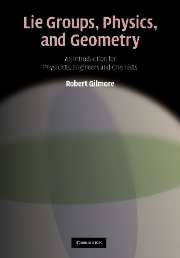Book contents
- Frontmatter
- Contents
- Preface
- 1 Introduction
- 2 Lie groups
- 3 Matrix groups
- 4 Lie algebras
- 5 Matrix algebras
- 6 Operator algebras
- 7 EXPonentiation
- 8 Structure theory for Lie algebras
- 9 Structure theory for simple Lie algebras
- 10 Root spaces and Dynkin diagrams
- 11 Real forms
- 12 Riemannian symmetric spaces
- 13 Contraction
- 14 Hydrogenic atoms
- 15 Maxwell's equations
- 16 Lie groups and differential equations
- Bibliography
- Index
15 - Maxwell's equations
Published online by Cambridge University Press: 05 September 2012
- Frontmatter
- Contents
- Preface
- 1 Introduction
- 2 Lie groups
- 3 Matrix groups
- 4 Lie algebras
- 5 Matrix algebras
- 6 Operator algebras
- 7 EXPonentiation
- 8 Structure theory for Lie algebras
- 9 Structure theory for simple Lie algebras
- 10 Root spaces and Dynkin diagrams
- 11 Real forms
- 12 Riemannian symmetric spaces
- 13 Contraction
- 14 Hydrogenic atoms
- 15 Maxwell's equations
- 16 Lie groups and differential equations
- Bibliography
- Index
Summary
The electromagnetic field E(x, t), B(x, t) is determined by Maxwell's equations. These equations are linear in the space and time derivatives. In the momentum representation, obtained by taking a Fourier transform of the electric and magnetic fields, Maxwell's equations impose a set of four linear constraints on the six amplitudes E(k), B(k). Why? At a more fundamental level, the electromagnetic field is described by photons. For each photon momentum state there are only two degrees of freedom, the helicity (polarization) states, corresponding to an angular momentum 1 aligned either in or opposite to the direction of propagation. Thus, the classical description of the electromagnetic field is profligate, introducing six amplitudes for each k when in fact only two are independent. The remaining four degrees must be absent in any description of a physically allowed field. The equations that annihilate these four nonphysical linear combinations are the equations of Maxwell. We derive these equations, in the absence of sources, by comparing the transformation properties of the helicity and classical field states for each four-momentum.
Introduction
The electromagnetic field has been described in two different ways. Following the nineteenth century approach (pre quantum mechanics), a field is introduced having appropriate transformation properties. The price one pays is that not every field represents a physically allowed state: such fields must be annihilated by appropriate equations.
- Type
- Chapter
- Information
- Lie Groups, Physics, and GeometryAn Introduction for Physicists, Engineers and Chemists, pp. 259 - 283Publisher: Cambridge University PressPrint publication year: 2008



